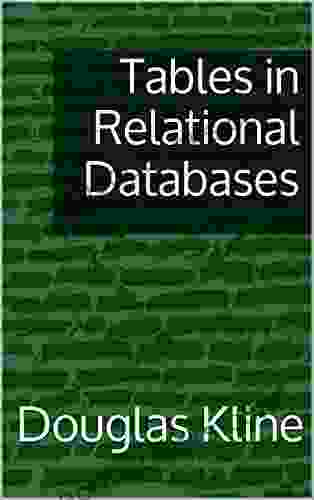Tables In Relational Databases: An Introduction to Relational Database Design

Relational databases are a powerful tool for storing and managing data. They are used in a wide variety of applications, from small business accounting systems to large enterprise data warehouses. The foundation of a relational database is the table. Tables are used to store data in a structured way, and they can be related to each other to create complex data models.
In this article, we will provide you with a comprehensive to tables in relational databases. We will cover the basics of tables, including their structure, components, and relationships. You will also learn how to create, modify, and delete tables, as well as how to insert, update, and delete data from tables.
A table is a collection of data that is organized into rows and columns. Each row in a table represents a single record, and each column represents a different field or attribute of the record. For example, a table of customer data might have columns for customer name, customer address, and customer phone number.
4 out of 5
| Language | : | English |
| File size | : | 968 KB |
| Text-to-Speech | : | Enabled |
| Screen Reader | : | Supported |
| Enhanced typesetting | : | Enabled |
| Print length | : | 12 pages |
| Lending | : | Enabled |
The structure of a table is defined by its schema. The schema specifies the name of the table, the names of the columns in the table, and the data type of each column. For example, the following schema defines a table named "customers":
CREATE TABLE customers ( customer_id INT NOT NULL AUTO_INCREMENT, customer_name VARCHAR(255) NOT NULL, customer_address VARCHAR(255) NOT NULL, customer_phone VARCHAR(255) NOT NULL );
The customer_id column is the primary key of the table. This means that it is a unique identifier for each record in the table. The customer_name, customer_address, and customer_phone columns are all non-null columns, which means that they cannot contain null values.
Tables are made up of several different components, including:
- Rows: Rows are the horizontal units of data in a table. Each row represents a single record.
- Columns: Columns are the vertical units of data in a table. Each column represents a different field or attribute of the record.
- Cells: Cells are the individual units of data in a table. A cell is the intersection of a row and a column.
- Primary key: The primary key is a unique identifier for each record in a table.
- Foreign key: A foreign key is a column that references a primary key in another table.
Tables can be related to each other in a variety of ways. The most common types of relationships are:
- One-to-one: A one-to-one relationship is a relationship in which each record in one table is related to only one record in another table. For example, a table of customers might have a one-to-one relationship with a table of Free Downloads, where each customer can only place one Free Download.
- One-to-many: A one-to-many relationship is a relationship in which each record in one table is related to multiple records in another table. For example, a table of customers might have a one-to-many relationship with a table of Free Downloads, where each customer can place multiple Free Downloads.
- Many-to-many: A many-to-many relationship is a relationship in which each record in one table is related to multiple records in another table, and each record in the other table is related to multiple records in the first table. For example, a table of customers might have a many-to-many relationship with a table of products, where each customer can Free Download multiple products and each product can be Free Downloadd by multiple customers.
Relationships between tables are defined using foreign keys. A foreign key is a column in one table that references a primary key in another table. For example, the following foreign key in the Free Downloads table references the customer_id primary key in the customers table:
ALTER TABLE Free Downloads ADD COLUMN customer_id INT NOT NULL REFERENCES customers(customer_id);
Tables can be created using the CREATE TABLE statement. The CREATE TABLE statement specifies the name of the table, the names of the columns in the table, and the data type of each column. For example, the following statement creates a table named "customers":
CREATE TABLE customers ( customer_id INT NOT NULL AUTO_INCREMENT, customer_name VARCHAR(255) NOT NULL, customer_address VARCHAR(255) NOT NULL, customer_phone VARCHAR(255) NOT NULL );
The AUTO_INCREMENT keyword specifies that the customer_id column will be automatically incremented for each new record that is inserted into the table.
Tables can be modified using the ALTER TABLE statement. The ALTER TABLE statement can be used to add new columns, drop existing columns, or change the data type of a column. For example, the following statement adds a new column named "customer_email" to the customers table:
ALTER TABLE customers ADD COLUMN customer_email VARCHAR(255) NOT NULL;
Tables can be deleted using the DROP TABLE statement. The DROP TABLE statement removes the table from the database. For example, the following statement drops the customers table:
DROP TABLE customers;
<h2>Inserting Data Into Tables</h2> Data can be inserted into tables using the `INSERT INTO` statement. The `INSERT INTO` statement specifies the name of the table,</body></html>4 out of 5
| Language | : | English |
| File size | : | 968 KB |
| Text-to-Speech | : | Enabled |
| Screen Reader | : | Supported |
| Enhanced typesetting | : | Enabled |
| Print length | : | 12 pages |
| Lending | : | Enabled |
Do you want to contribute by writing guest posts on this blog?
Please contact us and send us a resume of previous articles that you have written.
 Book
Book Novel
Novel Page
Page Chapter
Chapter Text
Text Story
Story Genre
Genre Reader
Reader Library
Library Paperback
Paperback E-book
E-book Magazine
Magazine Newspaper
Newspaper Paragraph
Paragraph Sentence
Sentence Bookmark
Bookmark Shelf
Shelf Glossary
Glossary Bibliography
Bibliography Foreword
Foreword Preface
Preface Synopsis
Synopsis Annotation
Annotation Footnote
Footnote Manuscript
Manuscript Scroll
Scroll Codex
Codex Tome
Tome Bestseller
Bestseller Classics
Classics Library card
Library card Narrative
Narrative Biography
Biography Autobiography
Autobiography Memoir
Memoir Reference
Reference Encyclopedia
Encyclopedia Sally Cabot Gunning
Sally Cabot Gunning Theodore P Druch
Theodore P Druch William E Prentice
William E Prentice Jeremy Fisher
Jeremy Fisher Jaimie Admans
Jaimie Admans Sam Dogra
Sam Dogra Sean Robins
Sean Robins Todd Erick Pedersen
Todd Erick Pedersen Scott Beatty
Scott Beatty Stuart Campbell
Stuart Campbell Theo Gaius
Theo Gaius Susan De Sola
Susan De Sola Taylor Wray
Taylor Wray Robert Burks
Robert Burks Seth Dickinson
Seth Dickinson Richard Morgan
Richard Morgan Carole Mortimer
Carole Mortimer Misty M Beller
Misty M Beller Tracie Vaughn Zimmer
Tracie Vaughn Zimmer William C Oakes
William C Oakes
Light bulbAdvertise smarter! Our strategic ad space ensures maximum exposure. Reserve your spot today!

 Herman MitchellThe American Labor Congress and the Welfare State: A Legacy of Shaping Social...
Herman MitchellThe American Labor Congress and the Welfare State: A Legacy of Shaping Social... Brennan BlairFollow ·18.2k
Brennan BlairFollow ·18.2k Timothy WardFollow ·16.2k
Timothy WardFollow ·16.2k Roald DahlFollow ·11.7k
Roald DahlFollow ·11.7k Aleksandr PushkinFollow ·3.6k
Aleksandr PushkinFollow ·3.6k Isaiah PowellFollow ·9.5k
Isaiah PowellFollow ·9.5k Juan ButlerFollow ·14.3k
Juan ButlerFollow ·14.3k Walter SimmonsFollow ·4.4k
Walter SimmonsFollow ·4.4k Seth HayesFollow ·2.9k
Seth HayesFollow ·2.9k

 Harry Cook
Harry CookRape Blossoms and White Sky: A Floral Symphony of...
A Kaleidoscope of Colors...

 Vic Parker
Vic ParkerThe Passion of Jovita Fuentes: Unveiling the...
Immerse yourself in the...

 Cormac McCarthy
Cormac McCarthySinners and Saints: A Dark New Adult High School Bully...
Sinners and Saints is...
4 out of 5
| Language | : | English |
| File size | : | 968 KB |
| Text-to-Speech | : | Enabled |
| Screen Reader | : | Supported |
| Enhanced typesetting | : | Enabled |
| Print length | : | 12 pages |
| Lending | : | Enabled |
















